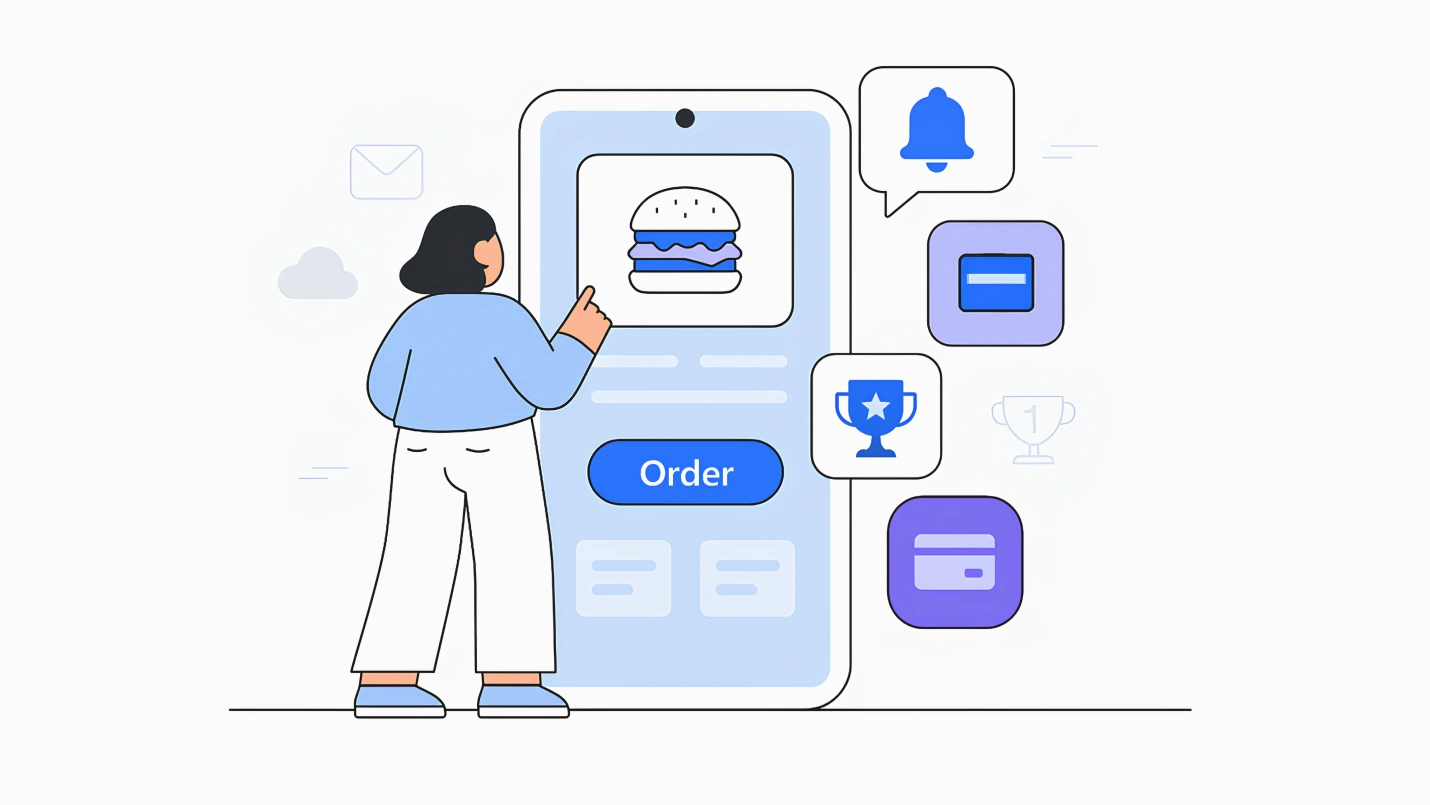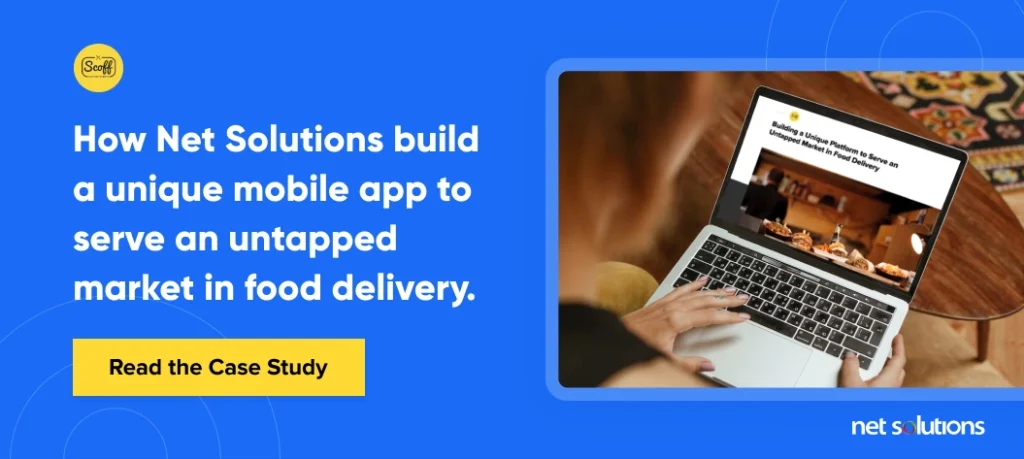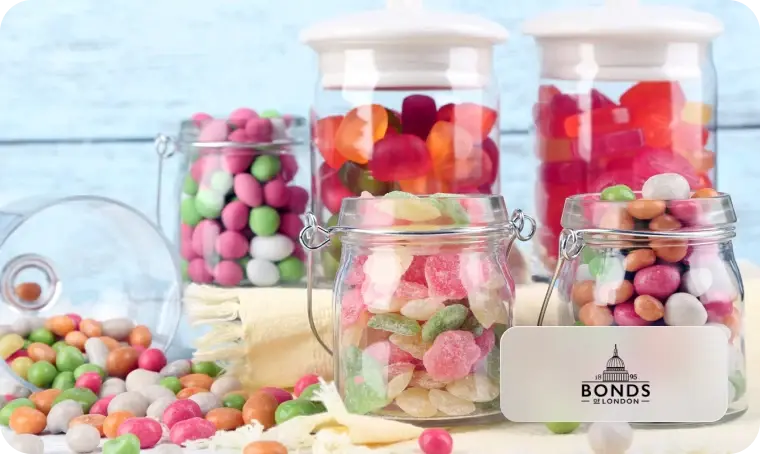Summary: The food delivery business has a strong growth curve, and if you’re planning to build an online food delivery app, this is the best time. What makes a food delivery app stand out? What features must you include to ensure success it stands out in the hypercompetitive online food delivery industry? Read on to find out.
Are you planning to create an online food ordering app but not sure whether it’s worth spending? Here are some findings from Statista to help you have a clear overview:
- As of 2022, the online food delivery segment has achieved $63.2 billion in revenue, resulting in 10.7% growth compared to the last year.
- The revenue is expected to grow at an annual growth rate (CAGR 2022-2027) of 8.90%, resulting in a projected market volume of $96.50 billion by 2027.
- Over 217.1 million users will be using online food-ordering apps by 2027.
As these stats show, the demand for online food ordering apps is high, and there’s no reason why you should miss out on them. But what features should an online food ordering app have?
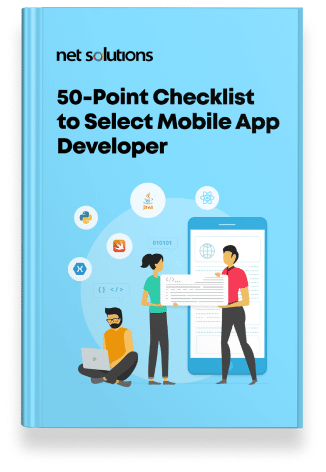
We respect your privacy. Your information is safe.
16 must-have features of an online food ordering app
1. Push Notifications
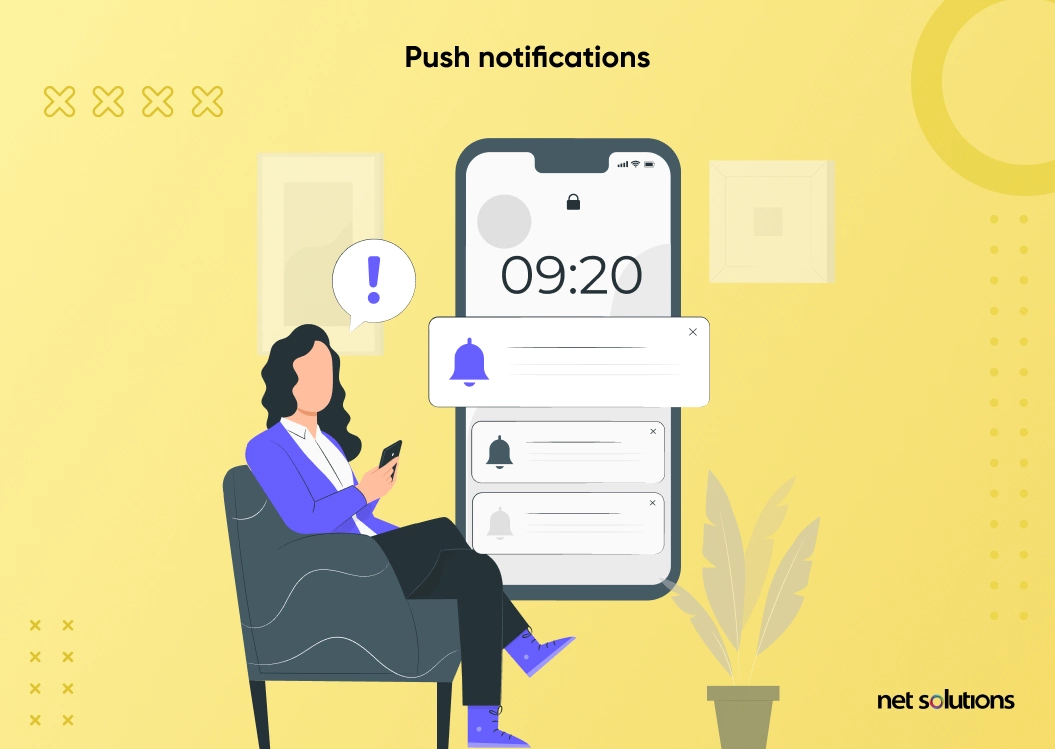
As most people prefer ordering food online these days, having more than one food delivery app on your smartphone is not uncommon. To create visibility and let you stay ahead of your competitors, sending push notifications is the best way. It helps businesses to stay connected with customers. These messages help to convey all kinds of information, such as discounts, offers, location-based order dropped messages, etc.
One more thing to ensure in your on-demand food ordering app is that your notifications must add value to the users rather than a plain commercial message. Try to manage push notifications in such a way that they help your business app grow substantially. Constantly notify your potential customers about discounts, special offers, and loyalty programs. This way, you can quickly grab customer attention and engage them.
2. Discount/Rewards, Cashback, and Loyalty Programs
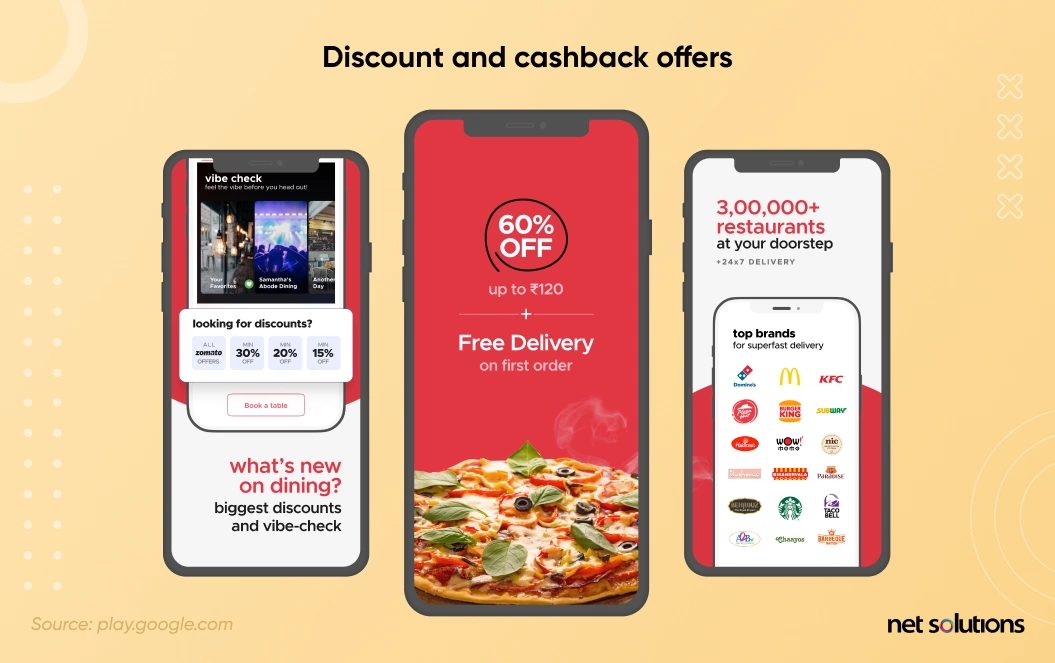
When attracting more customers to your food delivery app, discounts and special offers are the best. It would be best if you routinely offered great deals to engage customers. According to the reports, around 40% of users use a food ordering app to look for discounts and cashback, while 25% use these apps to earn loyalty points.
It’s critical to draw in potential customers to win brand loyalty than to create brand awareness. That’s why big companies pay more attention to their loyalty points. For example, when launching loyalty programs, Starbucks effectively expanded its sales by 80%.
3. Real-Time GPS Tracking
Real-time GPS tracking is one of the essential features of food delivery apps that enable customers to track the location of their food in real-time. The purpose of GPS is to offer two-way tracking as well as functioning. It helps to recognize the user’s location to deliver the food. And once the area is confirmed, users can easily track the progress and movement of the delivery personnel.
The leading food delivery apps use real-time GPS tracking to offer the best experience to customers. A few excellent APIs for this feature include Google Maps, MapKit, and Waze’s Navigation. For example, Uber uses Google Maps on all its platforms.
4. Easy Payment Options
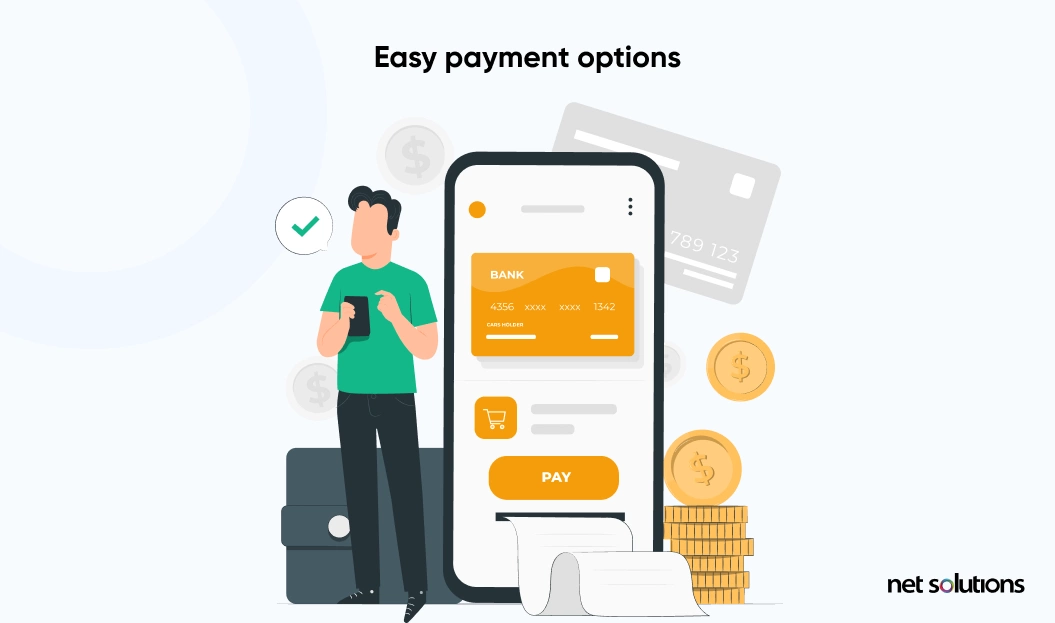
From a business owner’s perspective, payments play a significant role in every business. Though it’s the last step in order placement, customers abandon the order if they face any minor/major problem. Some don’t even try again. So, to make the payment procedure exceedingly productive and straightforward, a customer must have all the payment options listed in the on-demand food delivery app.
You can incorporate all the payment gateways or mobile wallet app services available in the market, such as Google Pay, PayPal, Amazon Pay, iOS Wallet, Stripe, Credit/Debit Card, Online Banking, and Cash On Delivery (COD) alternatives. You can likewise offer promo or voucher code usage from a similar page.
5. Social Media Integration
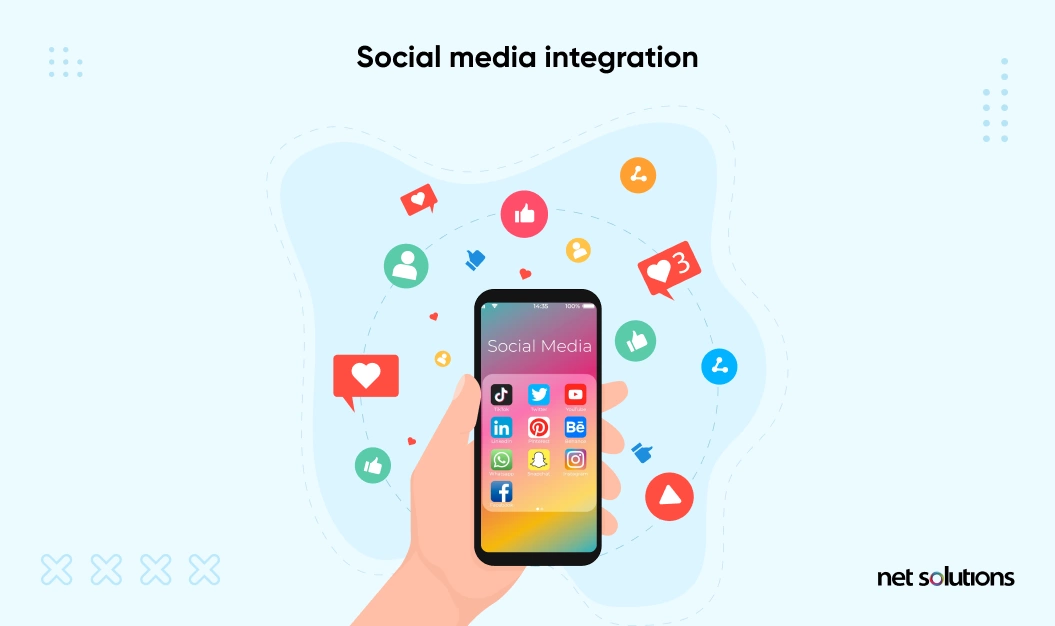
There’s no doubt that in the past few years, social media has contributed a lot to online marketing. It is one of those unpretentious viewpoints which improve customers’ decisions. With social media integration, customers can easily share photos or videos of their favorite dishes with friends and family. It would also make your online food ordering app noticeable on social media and can easily attract customers regularly.
Customers can leverage the most out of social media. Businesses can connect social media with loyalty/discount programs to attract existing customers to earn points and rewards by inviting new customers. It draws in potential customers while attracting a one-time customer to become a recurrent one.
6. Reviews & Ratings
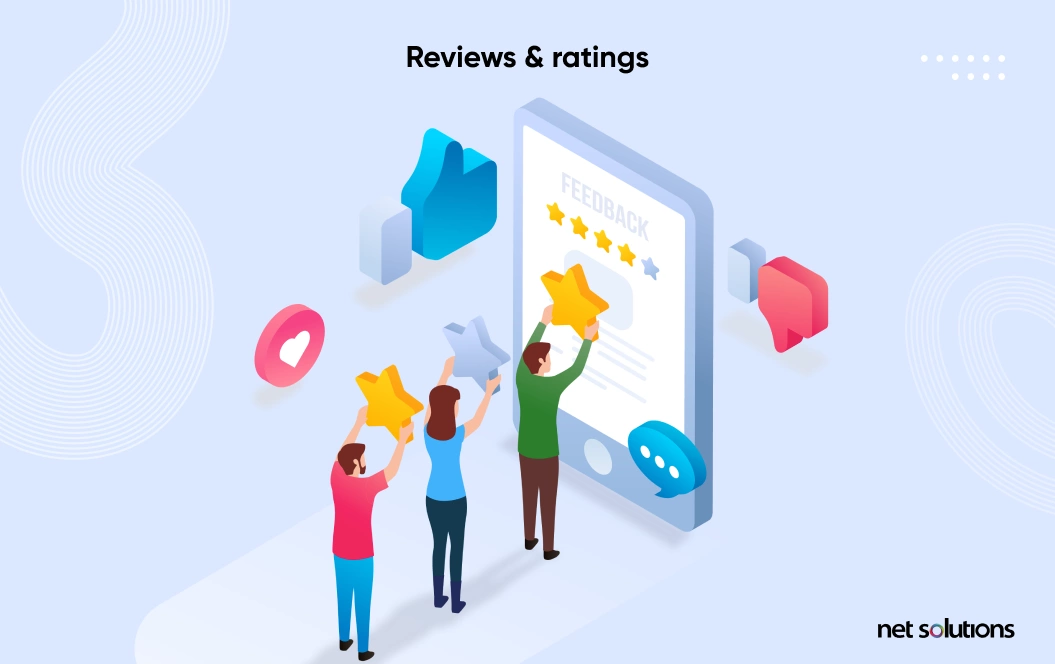
Every business cares for its customers as they’re the ones who ultimately buy products or services. Hence, it’s essential to know whether an on-demand app meets their needs or not. Every online food delivery app must have a review and rating feature. It would help your customers rate and review various restaurants with their listed dishes on the app.
Reviews and ratings are a well-tested and great way for businesses to know how customers respond to their apps. If your app is rated well, then the chances are high that lots of people will prefer visiting your app. Therefore, adding a feedback portal would help your business get instant and quick bites of knowledge to get insights into what amendments to be made in your app in the future for a better customer experience.
7. Easy Order Placement
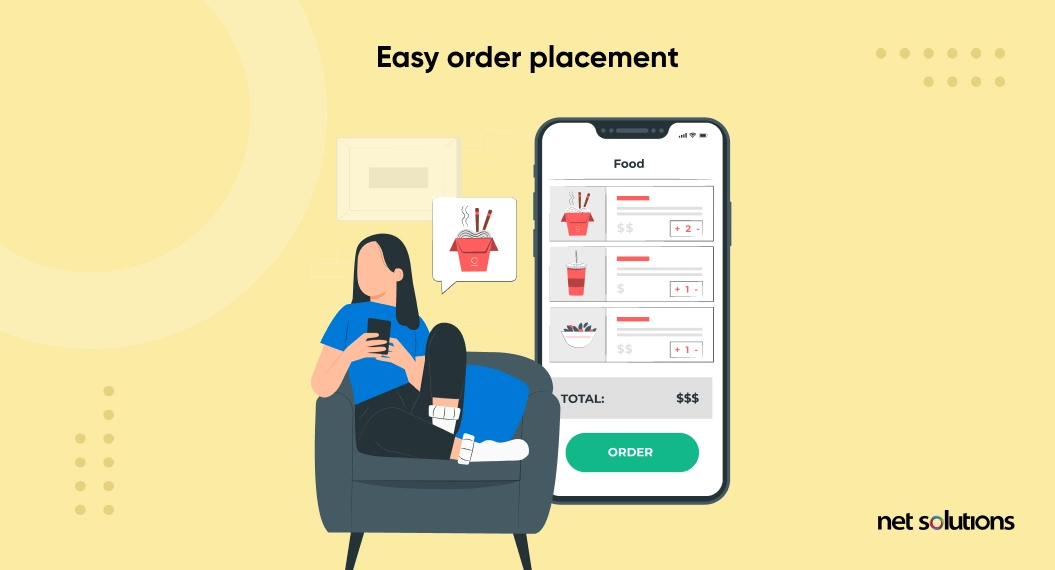
Most people prefer to order online because the order placement process is quick and straightforward. It is only possible if you have designed your food delivery app to be user-friendly. On-demand food delivery app must have an excellent user interface (UI) design. A user interface is an essential part of the app through which users communicate with the app and order services.
The users should be able to explore and discover what they need effectively. If the UI takes time to load, the user experience will be affected. It is considered a significant component of the app for its progress. It must load all the elements quickly for a great user experience with better app engagement and conversion rate.
8. Order scheduling and pickup
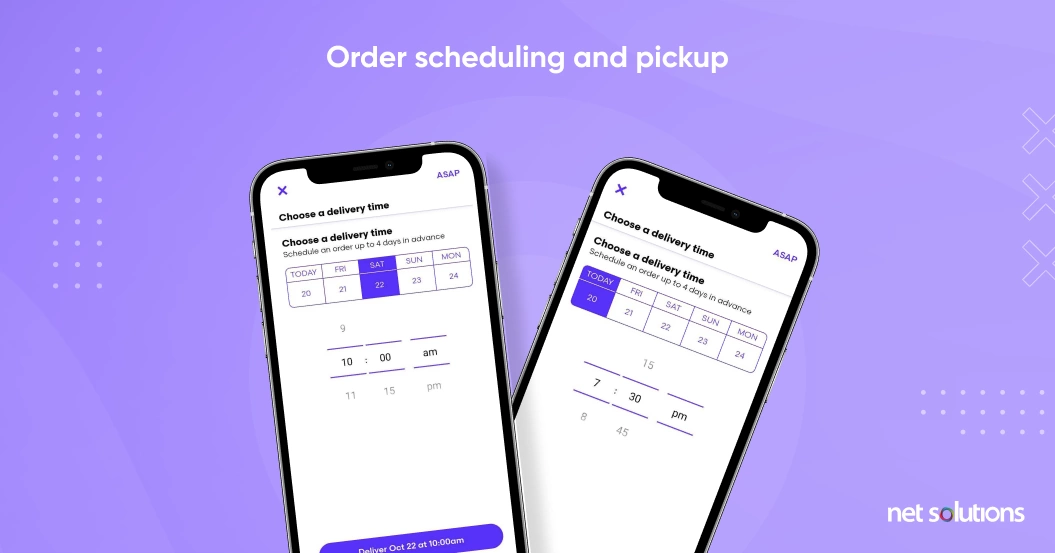
A person is working in the office, and their wife rings them up, saying she wants Chinese for dinner. Eating out is not an option because all the restaurants are packed. So, they check out a food ordering app and scroll for Chinese cuisine from the menu. After scrolling and a call with the wife, they order Kung Pao Chicken, Mongolian Beef, and Hunan Shrimp.
Everything’s settled, except they don’t want to order it now because it will get cold. What to do now?
The order scheduling and pickup feature are handy for such situations. Using it, they can schedule the order at their convenience and pick it up on the way home from the office. This way, they can save precious time and ensure they enjoy a warm, romantic dinner with their significant other.
9. QR Codes
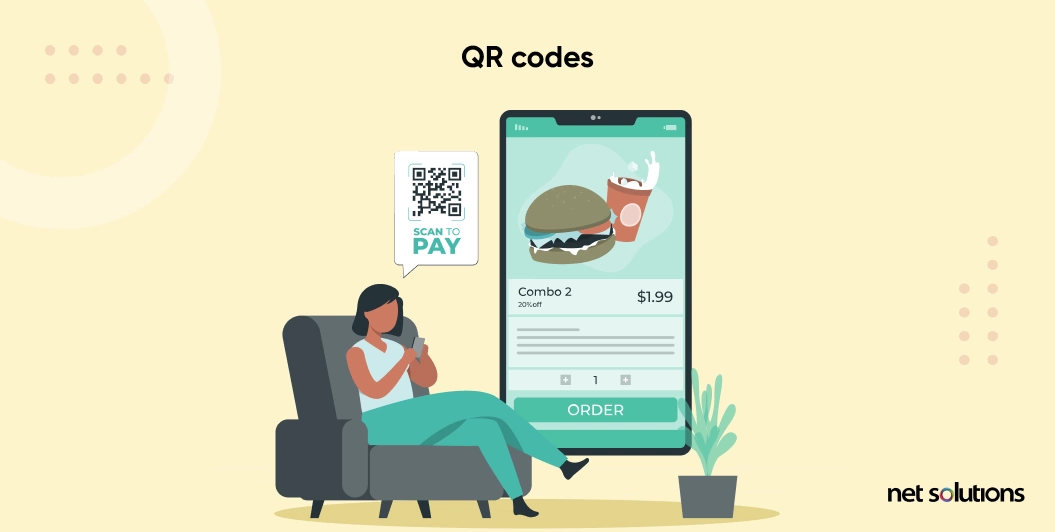
QR codes can be a valuable addition to online food-ordering apps. Many customers can do with them, like quickly scanning the menu to order their favorite meal and seamlessly making payments. They can also use these QR codes to share their referral code with friends or on social media.
Popular food ordering and delivery app Grubhub uses QR codes to let users quickly pay for their orders.
10. Geofencing
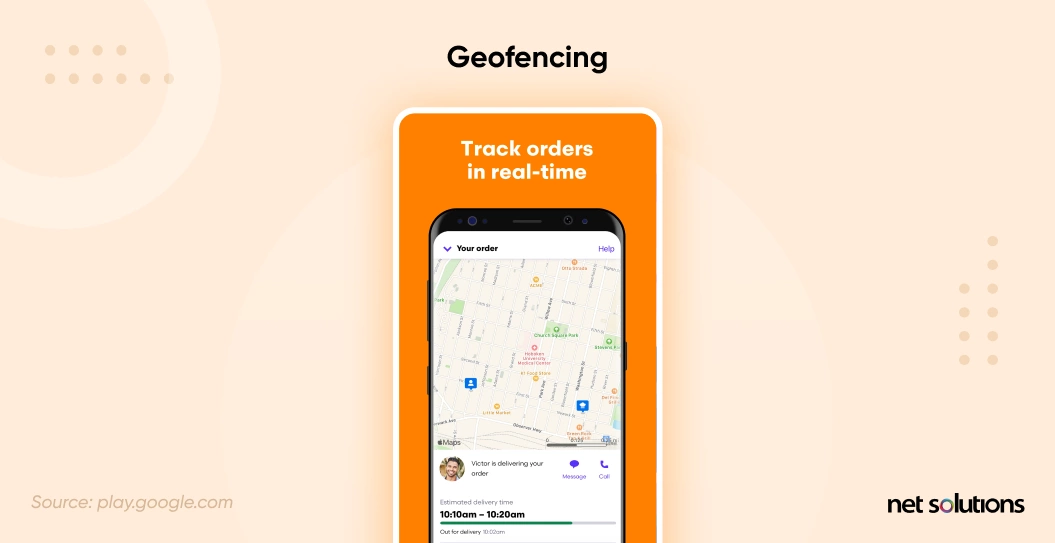
One of the most common issues that customers face with online food delivery apps is that their order isn’t delivered on time, and the food gets cold by the time it reaches their doorstep.
The geofencing feature solves this problem by predicting the estimated delivery time and ensuring a fresh meal reaches customers’ doorstep. With geofencing, you can also inform customers if there’s high traffic at the restaurant and you can’t serve their order at the moment. This way, you’ll effectively manage their expectations and ensure you don’t rub them off the wrong way.
11. Search Filters
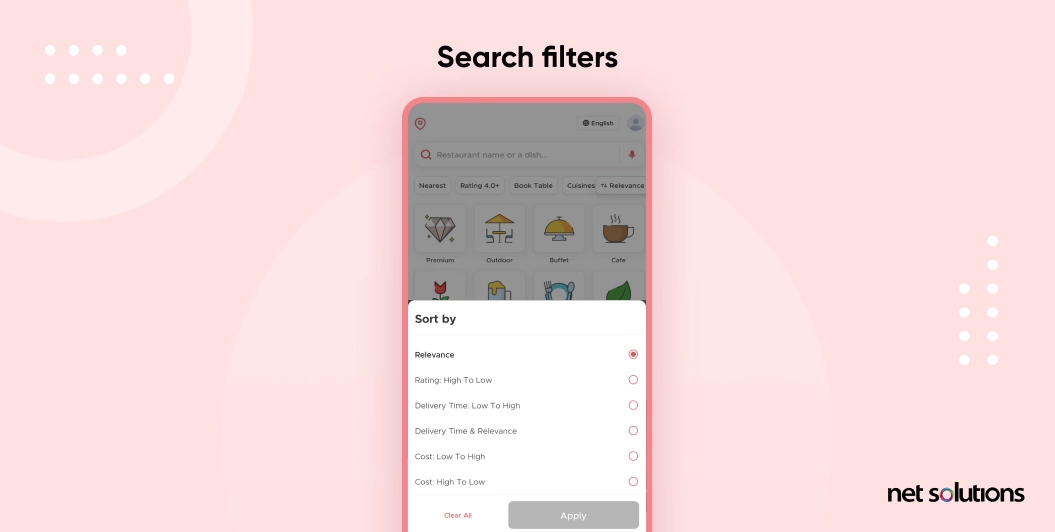
The last thing customers want is to spend hours searching for food, incredibly when hungry. Hence, you must integrate smart search filters so they can easily search for the right restaurant and place their order.
Delivery time, food type, preferences, location, distance, and ratings are some search filters you can offer in your on-demand food delivery app. Also, you can research food preferences to help users better find the food of their choice.
Also, don’t forget to give users numerous options. People love it when they have a lot of choices to explore. Grubhub and UberEats also offer a wide selection of foods to their target audience, so they don’t have to go elsewhere to look for a savory meal.
12. Order History
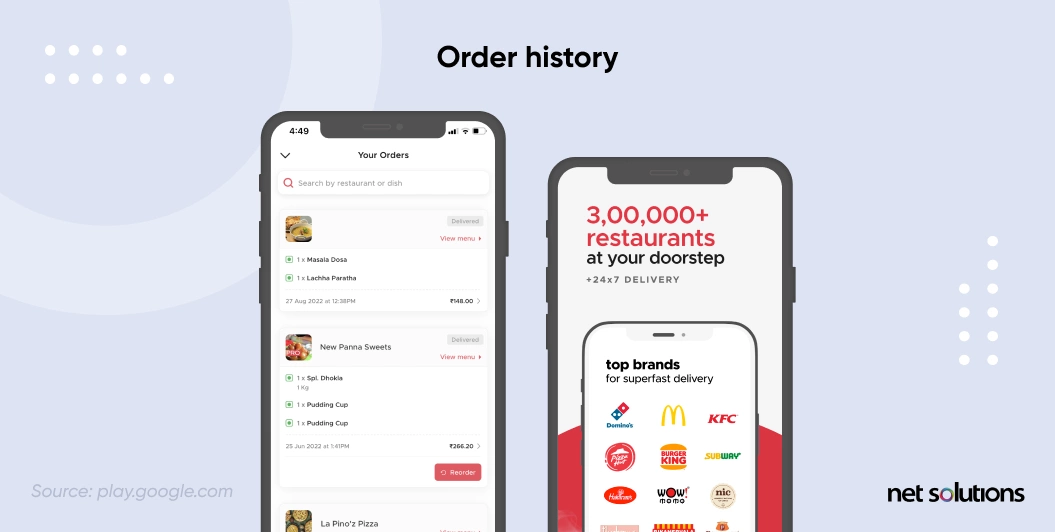
Suppose you ordered a pizza from Scarr’s that you enjoyed a lot. A few weeks later, you want to order the same pizza again. What would you do? Search for the name of the restaurant in the food app. You can, but what if you forget its name? We all do in the day-to-day hustle and bustle. That’s why the order history feature is very efficient. Users can review their previous orders and place their favorite orders again. They no longer have to remember the names of restaurants and dishes they can’t pronounce.
13. In-app Messages
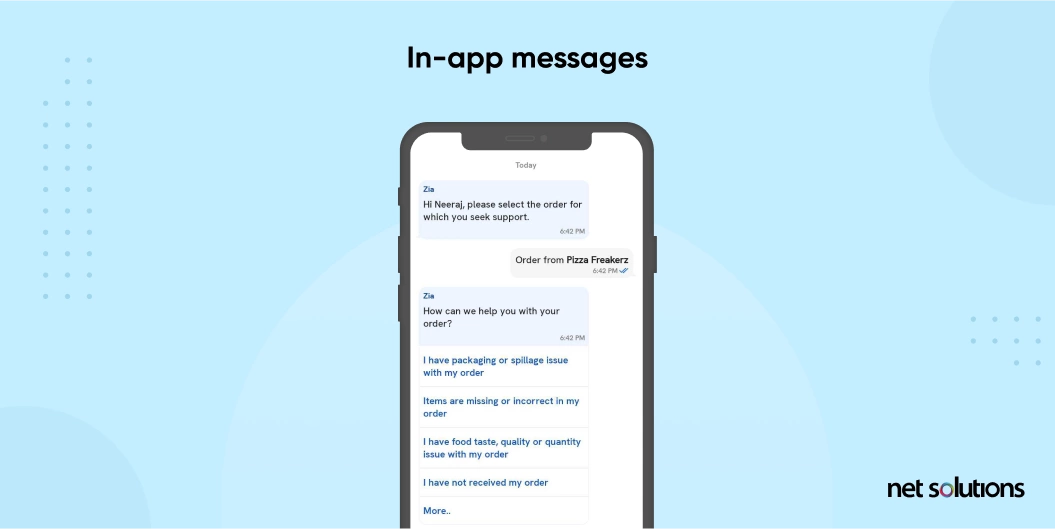
In-app messages are the alerts that appear on users’ screens while the app is open. The idea is to deliver targeted and context-sensitive information.
The in-app messages feature is helpful in scenarios when communication between restaurants and customers becomes essential. For example, sometimes customers want to clarify specifics with the administration or inform the restaurant that they delivered a wrong order by mistake.
Besides, the in-app messaging feature bridges the communication gap between customers, restaurants, and delivery workers. The restaurant updates the order’s status and ensures it reaches customers on time. If the order is late, the customer can drop a text message. Similarly, delivery staff can drop a text message to update their status or confirm the address.
Hence, every online food ordering app must have an in-app messaging feature.
14. Favorites (restaurants/dishes)
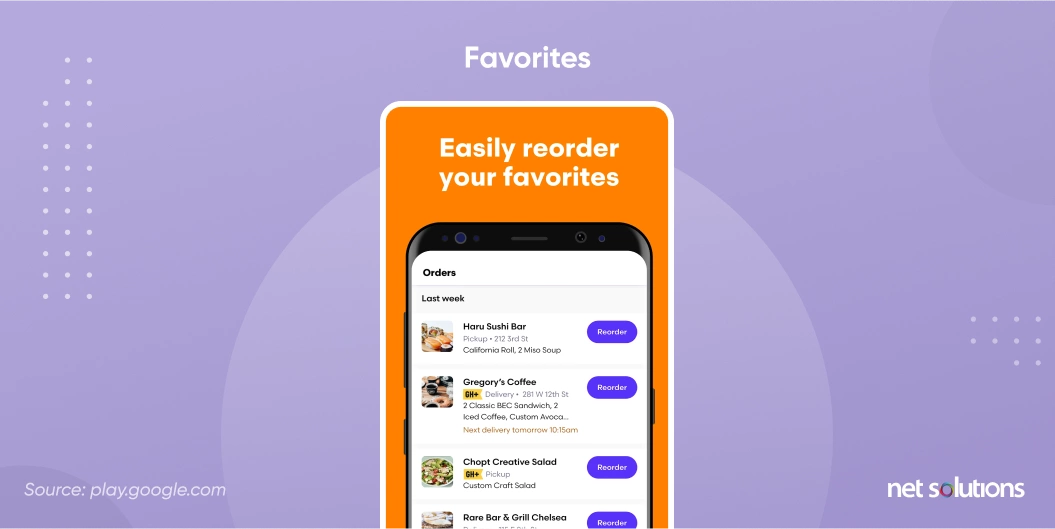
Another thing customers despise in online food ordering apps is repeatedly having to search for their favorite restaurants and words. Instead, they want an intelligent feature that takes away this hassle and ensures they order from one place.
You can add a feature that allows customers to mark their favorite dishes and restaurants. These market restaurants will stay on top of your feed, making them easily accessible. UberEats and GrubHub both use this feature.
15. Contactless delivery
Customers have become cautious about the human touch post the COVID pandemic, and the fear of infection scares them often. Hence, more and more of them now prefer a contactless food ordering experience.
Seeing this, many famous online food delivery applications like Doordash and Pizzahut have started offering contactless delivery experiences. They eliminate direct contact by ensuring that the delivery person knocks or rings the customer’s doorbell and then steps back 6-feet. This way, the customers can ensure their safety while enjoying the best food delivered to their doorstep.
16. Voice integration
The number of digital voice assistants will reach 8.4 billion units by 2024, higher than the world’s population. (Statista)
Most people rely on smart speakers like Alexa or Siri to listen to music, call friends, or even order food. Hence, it’s essential to have this feature integrated into online food delivery apps. It would make ordering food online hassle-free and involve your customers while delivering orders. You can also offer food coupons and upsell meals with these voice integration options.
Many online food order apps use voice integration. For example, GrubHub offers integration with Alexa to allow customers to repurchase previous orders or provide a rough delivery schedule for its delivery.
How can Net Solutions help you build the right online food-ordering app?
Whether you’re a restaurant owner hoping to improve your sales, customer loyalty, and retention rate, or an entrepreneur investing in your next big online food ordering service project, the above features are a must-have in your app to improve the user experience.
However, only features don’t make a food delivery app successful. It must also ease the ordering process and offer a great customer experience.
You can approach a mobile app development services provider to ensure your food app idea is successful. We have 22 years of experience in developing successful food delivery apps. Contact us!
Frequently Asked Questions
You can follow these tips to improve your food delivery app:
- Validate your food delivery idea before building the app to ensure you don’t create a clone of already existing apps.
- Focus on offering a unique experience with the theme and elements of your food delivery app.
- Carefully choose your target audience. You can’t cater to everyone and hope to build a unique mobile app.
- Research existing mobile apps but don’t let them influence your vision. It should be original and unique.
Depending on the complexity and the number of features involved, a food delivery app can cost anywhere between $60,000 – $150,000.
The choice of technology stack for an online food ordering app depends upon your requirements and the features you want to include in it. However, here are a few technology stacks mostly used in such applications:
- Admin panel and API: React.JS in Frontend and Node.Js in the backend.
- Delivery and user app: Java, Kotlin, or Android Studio for Android development, Objective C, Swift, and Xcode for iOS development, and Flutter for cross-platform app development.
The time to develop a food delivery app depends on its complexity. You can create a simple online food ordering app with customer and admin roles in 2-3 months. However, developing the same app with advanced features like payment processing or geo-tracking would take around nine months.

